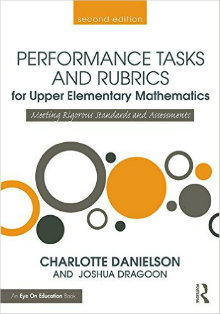First-Rate Math Tasks & Rubrics (Grades 4-5)
Performance Tasks and Rubrics for Upper Elementary Mathematics: Meeting Rigorous Standards and Assessments, 2nd Edition
By Charlotte Danielson and Joshua Dragoon
(Routledge/Eye on Education, 2016 – Learn more)

I confess I had a couple of ulterior motives in asking to review this book. In my job as the district’s math lead teacher, I am always on the lookout for rich tasks that will give students an opportunity to confront tasks that have a high cognitive demand. Therefore, I was itching to see the tasks in this book.

Moreover, although our district does not use Danielson’s Framework for Teaching in our teacher evaluation, her reputation as an expert in the assessment community was another reason I wanted to read this book.
I was hooked from the opening chapter
From the title alone, I felt that the book was a perfect fit for my needs, but it got even better when I opened the book to the first chapter. I was hooked from the opening paragraph which sums up the book in just a couple of sentences.
This book concerns the classroom use of performance assessment, and the evaluation of student work in response to performance tasks. It contains a collection of performance tasks in upper elementary school mathematics, but also includes guidance for educators to design or adapt performance tasks for their own use and to be a wise consumer of performance tasks that may be available to them.”
My school district has embarked on a journey from traditional grading to using a standards-based approach to grading. We spent over a year developing proficiency scales for each of the Common Core State Standards in mathematics. Once completed, we wanted a way to assess students’ level of mastery to put the scales into use. That meant working on aligning tasks and assessments with our own proficiency scales.
None of the teachers involved in the creation of our district assessments is a professional test-maker so we looked for resources we could tap. Since nothing was an exact fit, we needed to adapt assessment tasks for our needs. Had we known about this book, what we created would have been so much better.
A great PD book if you’re starting such a journey
If there were such a thing as a time machine that would allow us to go back to the beginning of our process, I would put it into use and begin by having our math leadership team participate in professional development with this book before developing our assessments.
In fact, I was delighted to see that the authors provide many sidebar boxes entitled “Professional Development Tips” offering easy-to-implement suggestions for using this book to support all educators in deepening their understanding around performance assessment.
Danielson and Dragoon strive to explain the important features of testing without getting bogged down in test design psychometrics. They give easily understood information defining what performance assessments are and the ways they are useful to teachers to drive instruction as well as provide feedback to students and parents.
The authors compare traditional testing, identified as tests using multiple-choice, true/false, matching, and short-answer formats, with performance tasks, demonstrating that each type is appropriate depending on the assessment goals. Traditional tests are easy to score, but focus on a small slice of student learning, and they can send students the message that mathematics is about knowing facts and procedures.
Performance tasks for learning
The use of performance tasks, however, sends the message that mathematics is not only about procedures, but also about sense making, persevering, reasoning, and working collaboratively to solve a problem. What resonated most with me was that performance assessment tasks require teachers to think deeply about what the standards mean in terms of what students must know and be able to do.
Although some of the Common Core Standards are written at a lower cognitive demand and could be measured using a traditional test, many are written at a Depth of Knowledge level 3 or 4. If we use assessments that measure students using questions requiring a level 1 or 2 when the standard is at a higher level, then we do our students a disservice.
Using well-designed performance tasks like the ones found in this book provide students ample experience in wrestling with complex, messy mathematics like the kind adults face everyday in real life, e.g., determining the best deal on dog food, deciding how much fencing to buy, or laying out a garden.
Creating and revising rubrics
After laying the groundwork for using performance tasks with students, the authors tackle the use of rubrics in scoring. Whether you’re a novice or expert at creating scoring rubrics, you’ll find helpful tips to use when developing them.
Factors to keep in mind include the number of standards to be measured, the need to match the type of rubric to the performance being evaluated, and where to place the dividing line between acceptable and unacceptable performance. You will also find tips for adapting existing rubrics to reflect your specific needs.
Danielson and Dragoon state more than once in their book that developing performance tasks and using scoring rubrics are integrally linked activities, and either or both may need to be revised after they have been piloted with students.
Another important practice is for teachers to come together to score student work. Through this process, teachers develop a shared understanding of student performance, and inter-rater agreement is created so that everyone scores the work the same.
A generous collection of performance tasks
Over half the book is devoted to the final chapter entitled “Upper Elementary Mathematics Performance Tasks.” There you will find a collection of tasks aligned to the CCSS (both content standards and Standards for Mathematical Practice) along with the scoring rubrics to use with students in grades three through five. Actual student work and the rationale for the scores received are given for some of the tasks which can be used as “anchor papers.”
Readers will be happy to learn that each of the tasks listed in the book is available as a downloadable file at the publisher’s website. These eResources are ready to use with students. Also, Danielson has partnered with other authors to write three other performance tasks books – one for early elementary, one for middle school, and one for high school. I haven’t read those books…yet.
You can also read Jan Roberts’ MiddleWeb review of Performance Tasks and Rubrics for Middle School Mathematics: Meeting Rigorous Standards and Assessments (2nd Edition) by Charlotte Danielson and Elizabeth Marquez.
Barb Rock @barbrokk has been an elementary teacher since 1989 and currently works as the Elementary Math Lead for the Sedro-Woolley School District in Washington State, providing professional development in math instruction and assessment. She also serves at the state level as a Math Fellow, assisting with implementation efforts of Washington State Learning Standards (CCSS). In her spare time, she loves scuba diving, spending time with her grandchildren, and riding her recumbent tricycle.


































